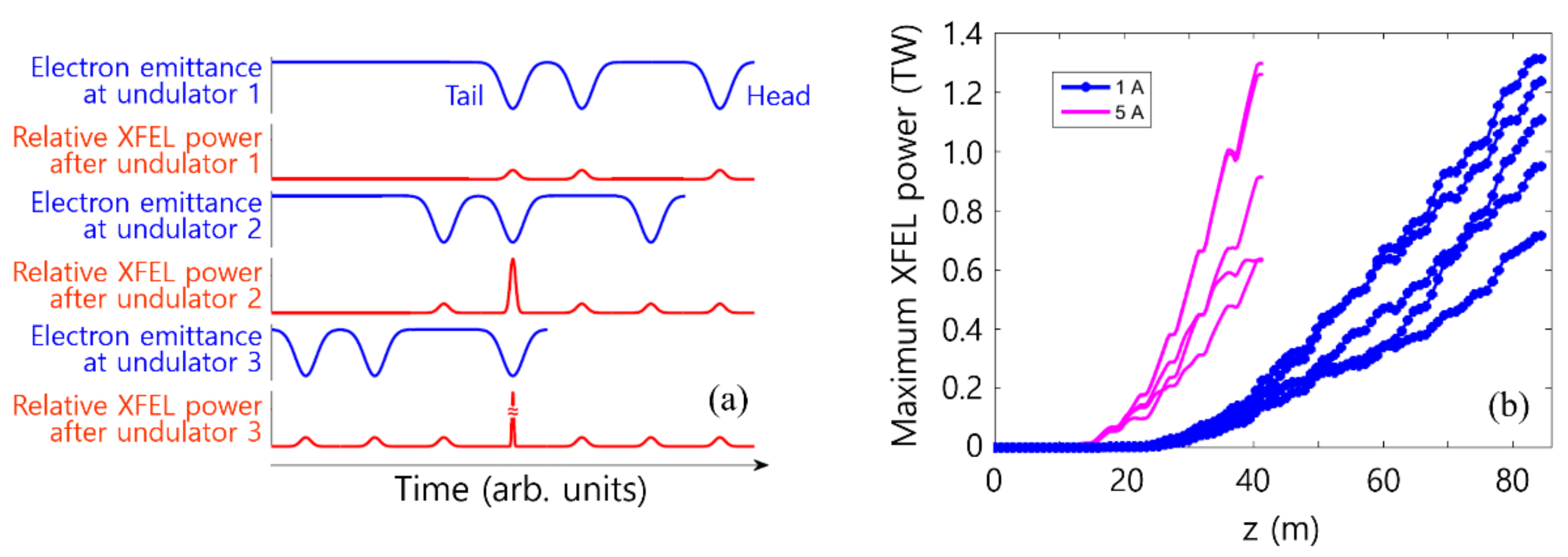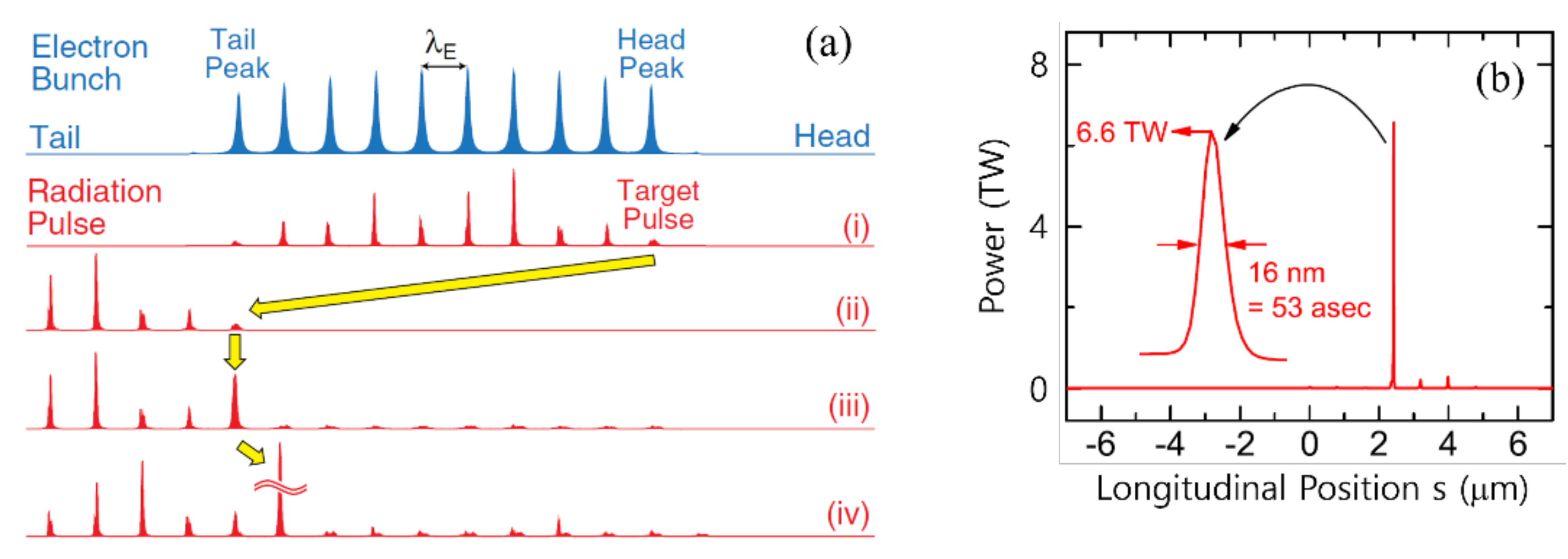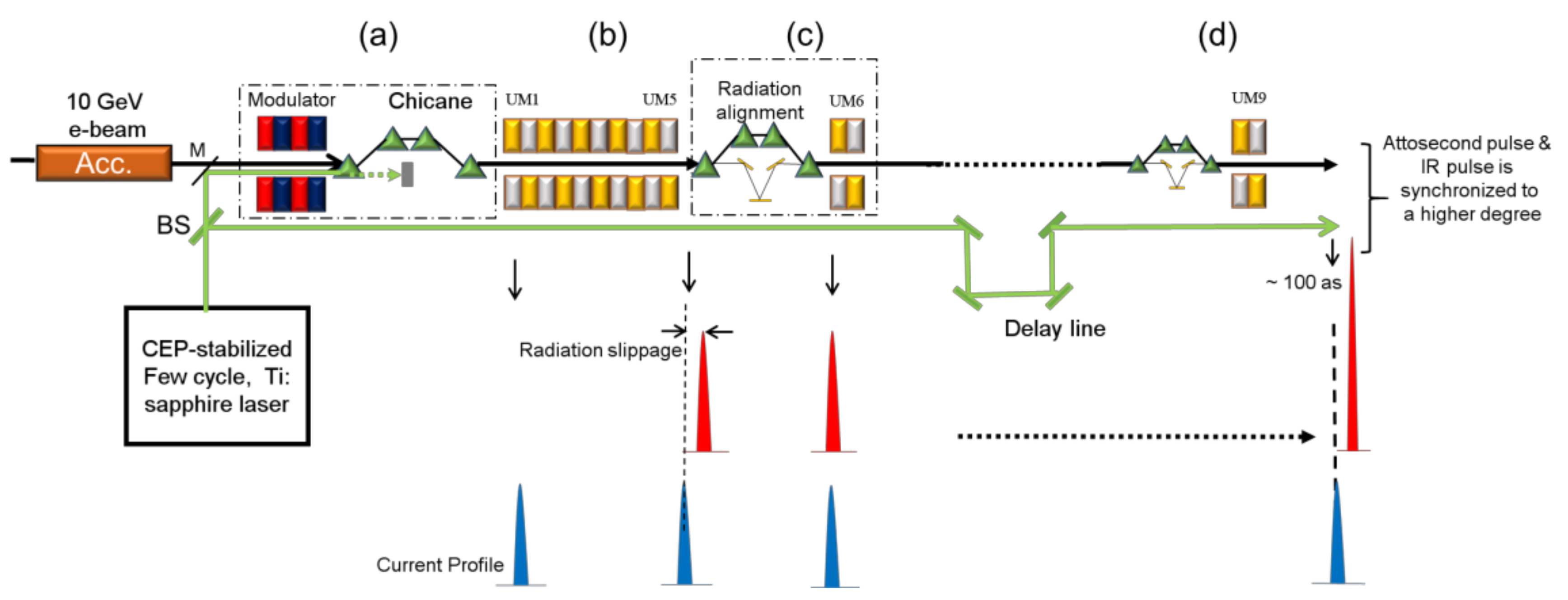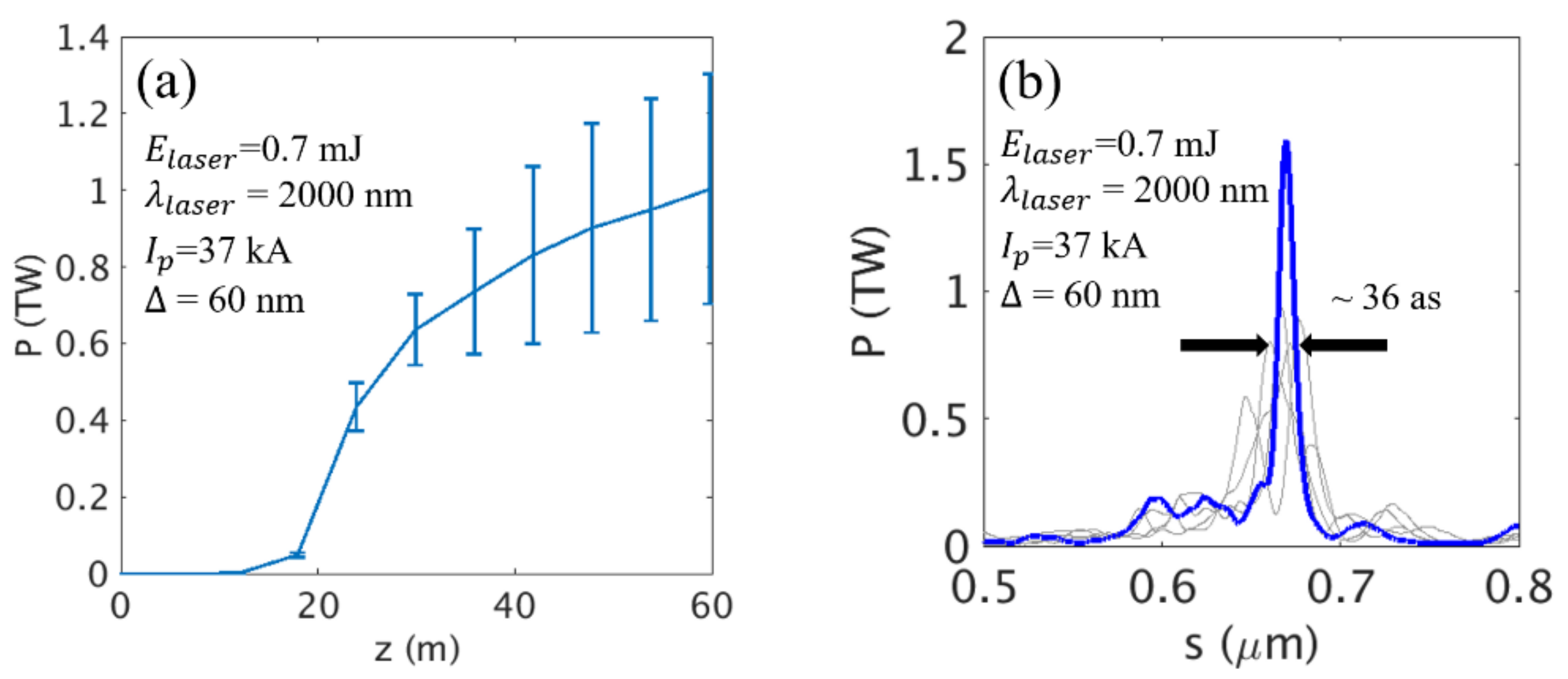Toward the Generation of an Isolated TW-Attosecond X-ray Pulse in XFEL
Abstract
1. Introduction
1.1. Direct Observation of Electron Clouds in Atoms and Molecules
1.2. Dynamics of New Material Status: Hollow Atoms and Warm Dense Matter
1.3. Single-Molecule Imaging
2. Methods without Current Modulation
2.1. Good Emittance Region Method
2.2. Good Trajectory Region Method
3. Methods with Current Modulation
3.1. Current Modulation Method
3.2. Regularly Spaced Multi-Current Spikes
3.3. Irregularly-Spaced Multi-Current Spikes
3.4. Single Current Spike I: Recycling Method
3.5. Single Current Spike II: Single Pass Method
4. Summary and Discussion
Author Contributions
Funding
Acknowledgments
Conflicts of Interest
References
- Krausz, F.; Ivanov, M. Attosecond physics. Rev. Mod. Phys. 2009, 81, 163. [Google Scholar] [CrossRef]
- Schafer, K.; Wei, Z.; Vrakking, M. Special issue celebrating 25 years of re-collision physics. J. Phys. B At. Mol. Opt. Phys. 2017, 50, 170201. [Google Scholar] [CrossRef]
- Calegari, F.; Ayuso, D.; Trabattoni, A.; Belshaw, L.; de Camillis, S.; Anumula, S.; Frassetto, F.; Poletto, L.; Palacios, A.; Decleva, P.; et al. Ultrafast electron dynamics in phenylalanine initiated by attosecond pulses. Science 2014, 346, 336. [Google Scholar] [CrossRef] [PubMed]
- Dixit, G.; Vendrell, O.; Santra, R. Imaging electronic quantum motion with light. Proc. Natl. Acad. Sci. USA 2012, 109, 11636. [Google Scholar] [CrossRef] [PubMed]
- Dixit, G.; Slowik, J.M.; Santra, R. Theory of time-resolved nonresonant X-ray scattering for imaging ultrafast coherent electron motion. Phys. Rev. A 2014, 89, 043409. [Google Scholar] [CrossRef]
- Fukuzawa, H.; Son, S.-K.; Motomura, K.; Mondal, S.; Nagaya, K.; Wada, S.; Liu, X.-J.; Feifel, R.; Tachibana, T.; Ito, Y.; et al. Deep Inner-Shell Multiphoton Ionization by Intense X-Ray Free-Electron Laser Pulses. Phys. Rev. Lett. 2013, 110, 173005. [Google Scholar] [CrossRef] [PubMed]
- Ernstorfer, R.; Harb, M.; Hebeisen, C.T.; Sciaini, G.; Dartigalongue, T.; Miller, R.J.D. The Formation of Warm Dense Matter: Experimental Evidence for Electronic Bond Hardening in Gold. Science 2009, 323, 1033. [Google Scholar] [CrossRef] [PubMed]
- Fratalocchi, A.; Ruocco, G. Single-molecule imaging with X-Ray free-electron lasers: Dream or reality? Phys. Rev. Lett. 2011, 106, 105504. [Google Scholar] [CrossRef] [PubMed]
- Emma, P.; Akre, R.; Arthur, J.; Bionta, R.; Bostedt, C.; Bozek, J.; Brachmann, A.; Bucksbaum, P.; Coffee, R.; Decker, F.-J.; et al. First lasing and operation of an ångstrom-wavelength free-electron laser. Nat. Photon. 2010, 4, 641. [Google Scholar] [CrossRef]
- Ishikawa, T.; Aoyagi, H.; Asaka, T.; Asano, Y.; Azumi, N.; Bizen, T.; Ego, H.; Fukami, K.; Fukui, T.; Furukawa, Y.; et al. A compact X-ray free-electron laser emitting in the sub-ångström region. Nat. Photon. 2012, 6, 540. [Google Scholar] [CrossRef]
- Kang, H.-S.; Min, C.-K.; Heo, H.; Kim, C.; Yang, H.; Kim, G.; Nam, I.; Baek, S.Y.; Choi, H.-J.; Mun, G.; et al. Hard X-ray free-electron laser with femtosecond-scale timing jitter. Nat. Photon. 2017, 11, 708–713. [Google Scholar] [CrossRef]
- Altarelli, M.; Brinkmann, R.; Chergui, M.; Decking, W.; Dobson, B.; Düsterer, S.; Grübel, G.; Graeff, W.; Graafsma, H.; Hajdu, J.; et al. (Eds.) The European X-Ray Free-Electron Laser—Technical Design Report; DESY: Hamburg, Germany, 2007. [Google Scholar]
- Ganter, R. (Ed.) Swiss FEL—Conceptual Design Report; PSI: Villigen, Switzerland, 2010. [Google Scholar]
- Huang, S.; Ding, Y.; Feng, Y.; Hemsing, E.; Huang, Z.; Krzywinski, J.; Lutman, A.A.; Marinelli, A.; Maxwell, T.J.; Zhu, D. Generating Single-Spike Hard X-Ray Pulses with Nonlinear Bunch Compression in Free-Electron Lasers. Phys. Rev. Lett. 2017, 119, 154801. [Google Scholar] [CrossRef] [PubMed]
- Marinelli, A.; MacArthur, J.; Emma, P.; Guetg, M.; Field, C.; Kharakh, D.; Lutman, A.A.; Ding, Y.; Huang, Z. Experimental demonstration of a single-spike hard-X-ray free-electron laser starting from noise. Appl. Phys. Lett. 2017, 111, 151101. [Google Scholar] [CrossRef]
- Marinelli, A. Towards Attosecond Science at LCLS and LCLS-II. In Proceedings of the International Particle Accelerator Conference, Vancouver, BC, Canadam, 2 May 2018; WEXGBD3. Available online: http://ipac2018.vrws.de/talks/wexgbd3_talk.pdf (accessed on 6 September 2018).
- Saldin, E.L.; Schneidmiller, E.A.; Yurkov, M.V. A new technique to generate 100 GW-level attosecond X-ray pulses from the X-ray SASE FELs. Opt. Commun. 2004, 239, 161–172. [Google Scholar] [CrossRef]
- Emma, P.; Bane, K.; Cornacchia, M.; Huang, Z.; Schlarb, H.; Stupakov, G.; Walz, D. Femtosecond and Subfemtosecond X-Ray Pulses from a Self-Amplified Spontaneous-Emission–Based Free-Electron Laser. Phys. Rev. Lett. 2004, 92, 074801. [Google Scholar] [CrossRef] [PubMed]
- Zholents, A.A.; Fawley, W.M. Proposal for Intense Attosecond Radiation from an X-Ray Free-Electron Laser. Phys. Rev. Lett. 2004, 92, 224801. [Google Scholar] [CrossRef] [PubMed]
- Zholents, A.A. Method of an enhanced self-amplified spontaneous emission for X-ray free electron lasers. Phys. Rev. Spéc. Top. Accel. Beams 2005, 8, 040701. [Google Scholar] [CrossRef]
- Saldin, E.L.; Schneidmiller, E.A.; Yurkov, M.V. Self-amplified spontaneous emission FEL with energy-chirped electron beam and its application for generation of attosecond X-ray pulses. Phys. Rev. Spéc. Top. Accel. Beams 2006, 9, 050702. [Google Scholar] [CrossRef]
- Reiche, S.; Musumeci, P.; Pellegrini, C.; Rosenzweig, J.B. Development of ultra-short pulse, single coherent spike for SASE X-ray FELs. Nucl. Instrum. Methods A 2008, 593, 45–48. [Google Scholar] [CrossRef]
- Thompson, N.R.; McNeil, B.W.J. Mode Locking in a Free-Electron Laser Amplifier. Phys. Rev. Lett. 2008, 100, 203901. [Google Scholar] [CrossRef] [PubMed]
- Xiang, D.; Huang, Z.; Stupakov, G. Generation of intense attosecond X-ray pulses using ultraviolet laser induced microbunching in electron beams. Phys. Rev. Spéc. Top. Accel. Beams 2009, 12, 060701. [Google Scholar] [CrossRef]
- Ding, Y.; Huang, Z.; Ratner, D.; Bucksbaum, P.; Merdji, H. Generation of attosecond X-ray pulses with a multicycle two-color enhanced self-amplified spontaneous emission scheme. Phys. Rev. Spéc. Top. Accel. Beams 2009, 12, 060703. [Google Scholar] [CrossRef]
- Chung, S.-Y.; Yoon, M.; Kim, D.E. Generation of Attosecond X-ray and gamma-ray via Compton backscattering. Opt. Express 2009, 17, 7853–7861. [Google Scholar] [CrossRef] [PubMed]
- Kim, D.; Lee, H.; Chung, S.; Lee, K. Attosecond keV X-ray pulses driven by Thomson scattering in a tight focus regime. New J. Phys. 2009, 11, 063050. [Google Scholar] [CrossRef]
- Chen, G.; Kim, B.; Ahn, B.; Kim, D.E. Pressure dependence of argon cluster size for different nozzle geometries. J. Appl. Phys. 2009, 106, 053507. [Google Scholar] [CrossRef]
- Hwang, S.W.; Lee, H.J.; Chung, S.Y.; Kim, D.-E. X-ray Radiation Emitted from the Betatron Oscillation of Electrons in Laser Wakefields. J. Korean Phys. Soc. 2010, 56, 309–314. [Google Scholar]
- Lee, K.; Chung, S.Y.; Park, S.H.; Jeong, Y.U.; Kim, D. Effects of high-order fields of a tightly focused laser pulse on relativistic nonlinear Thomson scattered radiation by a relativistic electron. Europhys. Lett. 2010, 89, 64006. [Google Scholar] [CrossRef]
- Kumar, S.; Kang, H.-S.; Kim, D.E. Generation of isolated single attosecond hard X-ray pulse in enhanced self-amplified spontaneous emission scheme. Opt. Express 2011, 19, 7537–7545. [Google Scholar] [CrossRef] [PubMed]
- Chung, S.-Y.; Lee, H.J.; Lee, K.; Kim, D.E. Generation of a few femtosecond keV X-ray pulse via interaction of a tightly focused laser co-propagating with a relativistic electron bunch. Phys. Rev. Spéc. Top. Accel. Beams 2011, 14, 060705. [Google Scholar] [CrossRef]
- Kumar, S.; Kang, H.-S.; Kim, D.-E. For the generation of an intense isolated pulse in hard X-ray region using X-ray free electron laser. Laser Part. Beams 2012, 30, 397–406. [Google Scholar] [CrossRef]
- Kumar, S.; Kang, H.-S.; Kim, D.-E. Attosecond Hard X-ray Free Electron Laser. Appl. Sci. 2013, 3, 251. [Google Scholar] [CrossRef]
- Kumar, S.; Kang, H.-S.; Kim, D.E. The effect of a radio-frequency phase of accelerating columns on the attosecond ESASE scheme. J. Phys. B At. Mol. Opt. Phys. 2013, 46, 164004. [Google Scholar] [CrossRef]
- Kumar, S.; Kim, D.-E.; Kang, H.-S. Tunable THz radiation generation using density modulation of a relativistic electron beam. Nucl. Instrum. Methods A 2013, 729, 19–24. [Google Scholar] [CrossRef]
- Tanaka, T. Proposal for a Pulse-Compression Scheme in X-Ray Free-Electron Lasers to Generate a Multiterawatt, Attosecond X-Ray Pulse. Phys. Rev. Lett. 2013, 110, 084801. [Google Scholar] [CrossRef] [PubMed]
- Prat, E.; Reiche, S. Simple Method to Generate Terawatt-Attosecond X-Ray Free-Electron-Laser Pulses. Phys. Rev. Lett. 2015, 114, 244801. [Google Scholar] [CrossRef] [PubMed]
- Prat, E.; Löhl, F.; Reiche, S. Efficient generation of short and high-power X-ray free-electron-laser pulses based on superradiance with a transversely tilted beam. Phys. Rev. Spéc. Top. Accel. Beams 2015, 18, 100701. [Google Scholar] [CrossRef]
- Tanaka, T.; Parc, Y.W.; Kida, Y.; Kinjo, R.; Shim, C.H.; Ko, I.S.; Kim, B.; Kim, D.E.; Prat, E. Using irregularly spaced current peaks to generate an isolated attosecond X-ray pulse in free-electron lasers. J. Synchrotron Rad. 2016, 23, 1273. [Google Scholar] [CrossRef] [PubMed]
- Wang, Z.; Feng, C.; Zhao, Z. Generating isolated terawatt-attosecond X-ray pulses via a chirped-laser-enhanced high-gain free-electron laser. Phys. Rev. Accel. Beams 2017, 20, 040701. [Google Scholar] [CrossRef]
- Kumar, S.; Parc, Y.W.; Landsman, A.S.; Kim, D.E. Temporally-coherent terawatt attosecond XFEL synchronized with a few cycle laser. Sci. Rep. 2016, 6, 37700. [Google Scholar] [CrossRef] [PubMed]
- Kumar, S.; Landsman, A.S.; Kim, D.E. Terawatt-Isolated Attosecond X-ray Pulse Using a Tapered X-ray Free Electron Laser. Appl. Sci. 2017, 7, 614. [Google Scholar] [CrossRef]
- Shim, C.H.; Parc, Y.W.; Kumar, S.; Ko, I.S.; Kim, D.E. Isolated terawatt attosecond hard X-ray pulse generated from single current spike. Sci. Rep. 2018, 8, 7463. [Google Scholar] [CrossRef] [PubMed]
- Serkez, S.; Geloni, G.; Tomin, S.; Feng, G.; Gryzlova, E.V.; Grum-Grzhimailo, A.N.; Meyer, M. Overview of options for generating high-brightness attosecond X-ray pulses at free-electron lasers and applications at the European XFEL. J. Opt. 2018, 20, 024005. [Google Scholar] [CrossRef]
- Borland, M. Elegant: A Flexible SDDS-Compliant Code for Accelerator Simulation. Adv. Photon Source 2000. [Google Scholar] [CrossRef]
- Reiche, S. GENESIS 1.3: A fully 3D time-dependent FEL simulation code. Nucl. Instrum. Methods A 1999, 429, 243. [Google Scholar] [CrossRef]
- Schulz, S.; Grguraš, I.; Behrens, C.; Bromberger, H.; Costello, J.T.; Czwalinna, M.K.; Felber, M.; Hoffmann, M.C.; Ilchen, M.; Liu, H.Y.; et al. Femtosecond all-optical synchronization of an X-ray free-electron laser. Nat. Commun. 2015, 6, 5938. [Google Scholar] [CrossRef] [PubMed]
- Cinquegrana, P.; Cleva, S.; Demidovich, A.; Gaio, G.; Ivanov, R.; Kurdi, G.; Nikolov, I.; Sigalotti, P.; Danailov, M.B. Optical beam transport to a remote location for low jitter pump-probe experiments with a free electron laser. Phys. Rev. Spéc. Top. Accel. Beams 2014, 17, 040702. [Google Scholar] [CrossRef]
- Chini, M.; Mashiko, H.; Wang, H.; Chen, S.; Yun, C.; Scott, S.; Gilbertson, S.; Chang, Z. Delay control in attosecond pump-probe experiments. Opt. Express 2009, 17, 21459–21464. [Google Scholar] [CrossRef] [PubMed]
- Saldin, E.L.; Schneidmiller, E.A.; Yurkov, M.V. On the coherent radiation of an electron bunch moving in an arc of a circle. Nucl. Instrum. Methods A 1997, 398, 373. [Google Scholar] [CrossRef]
- Borland, M.; Chae, Y.C.; Emma, P.; Lewellen, J.W.; Bharadwaj, V.; Fawley, W.M.; Krejcik, P.; Limborg, C.; Milton, S.Y.; Nuhn, H.-D.; et al. Start-to-end simulation of self-amplified spontaneous emission free electron lasers from the gun through the undulator. Nucl. Instrum. Methods A 2002, 483, 268. [Google Scholar] [CrossRef]









| Reference | ||||||
|---|---|---|---|---|---|---|
| Parameter | [38] | [39] | [37] | [40] | [42] | [44] |
| Photon energy (keV) | 12.4 | 12.4 | 10 | 7.7 | 12.4 | 12.4 |
| FEL power (TW) | 0.95 | 2.38 | 6.6 | 1.8 | 1.2 | 1.5 |
| Pulse duration (as) | 142 | 363 | 53 | 62 | 100 | 36 |
| Beam energy (GeV) | 5.8 | 5.8 | 8 | 7 | 10 | 10 |
| Peak current (kA) | NA | NA | 12–18 | 5 | 33 | 35 |
| Inherent synchronization | No | No | Yes | Yes | Yes | Yes |
© 2018 by the authors. Licensee MDPI, Basel, Switzerland. This article is an open access article distributed under the terms and conditions of the Creative Commons Attribution (CC BY) license (http://creativecommons.org/licenses/by/4.0/).
Share and Cite
Parc, Y.W.; Shim, C.H.; Kim, D.E. Toward the Generation of an Isolated TW-Attosecond X-ray Pulse in XFEL. Appl. Sci. 2018, 8, 1588. https://doi.org/10.3390/app8091588
Parc YW, Shim CH, Kim DE. Toward the Generation of an Isolated TW-Attosecond X-ray Pulse in XFEL. Applied Sciences. 2018; 8(9):1588. https://doi.org/10.3390/app8091588
Chicago/Turabian StyleParc, Yong Woon, Chi Hyun Shim, and Dong Eon Kim. 2018. "Toward the Generation of an Isolated TW-Attosecond X-ray Pulse in XFEL" Applied Sciences 8, no. 9: 1588. https://doi.org/10.3390/app8091588
APA StyleParc, Y. W., Shim, C. H., & Kim, D. E. (2018). Toward the Generation of an Isolated TW-Attosecond X-ray Pulse in XFEL. Applied Sciences, 8(9), 1588. https://doi.org/10.3390/app8091588





